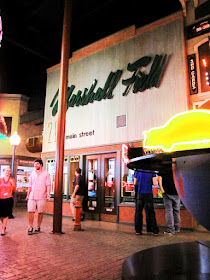A Dream Comes True
With the opening of the new American Sign
Museum (www.signmuseum.org) on June 23 this year, museum founder Tod Swormstedt achieved one of his
dreams. As I walked past the brightly lit exhibits, I thought about what
Napoleon Hill, author of Think and Grow
Rich, had said: what a man can conceive of and believe in, he can achieve.
As Tod can attest to, achieving your dream is
never easy. It takes a clear vision. It takes unwavering belief. And above all,
it takes lots of help and support from great friends.
Planning began five years earlier, after Tod
had purchased a 93-year old tool plant in 2007 in the Camp Washington community of Cincinnati, OH.
The factory was part of what had been an old manufacturing complex, which is listed in the
National Register of Historic Places.
After Christmas that year, Tod had given me a
tour of the building. At that time, the property was little more than an old,
poorly-lit empty factory. Many of the windows were broken and you could feel
the rush of cold air, which blew through the broken panes of glass. The
concrete floor of the building was cracked and uneven. And water from the
melting snow was dripping from the leaky roof above.
The property was definitely a fixer-upper, but
it did have possibilities. As a historic
building, it was the perfect location for a museum. The site’s biggest assets,
though, were its floor space and its ceiling height. The 42,000-square foot property has
10 times more space than the previous location – enough room to exhibit the
museum’s collection of more than 500 signs. And with 28-foot ceilings, electrical signs, which were too large to exhibit in the old facility, such
as a classic 25-foot-tall McDonald's sign, are now easily accommodated within
the walls of the new museum.
Plus, this location offers the possibility
for expansion – Tod’s next project.
As we toured the building, Tod pointed from
one part of the old factory to another, describing how he envisioned the museum
would look when it opened. “Against that wall will be the entire side of barn painted
with a Mail Pouch Tobacco ad,” he explained. Earlier that year Tod had recruited a
team of sign makers and friends to help him dismantle a 50-foot long Mail Pouch
barn. The planks were numbered to aid
reassembly in the museum’s future home.
In the center of the museum, Tod explained how they would
recreate Main Street in the small town of Signville. This walk down memory lane
includes life-size storefronts from a prototypical small American town,
including a Marshall Field’s department store, a Firestone Tire Store, a
jewelry store, a barber shop and a gas station.
Window displays would showcase different types of signage
from years past. One storefront would
house a functional neon shop. No, the art of neon tube bending is not dead. The
American Sign Museum will keep the craft alive with a working shop, allowing visitors
an opportunity to view a craft of the past. Other areas of the museum feature displays of
porcelain signs, dimensional letters, posters and glue chipped and gilded glass
signs.
Many of his friends in the sign community shared Tod’s vision and
helped him in the completion of the new museum. Tod credits David Butler and
his wife Suzie with organizing a group of 29 sign artists, who devoted eight
ten-hour days to decorate the windows and walls of the Main Street storefronts,
complementing the display of vintage signs.
Artists from across the United States and Canada, who worked on the
project, included Phil Ghi, Gary Godby, Gregg Heger, Jeff Lang, Kent Smith, Bob
Canning, Joe Broxterman, Doug Bernhardt, Roger Crice, Anna Weber, Noel Weber,
Noella Cotnam, Elaine Wallis, Karen Souza, Bill Reidel, Sonny Franks, Tom
Seibert, Jane Diaz, Robin McDonald, Dave McDonald, Cosmic Ray Renooy, Doc
Welty, Nancy Bennett, Dave Correll, Mike Meyer and Sean Druley. (The You Tube clip http://www.youtube.com/watch?v=jhjQbRs96Z8 highlights the Main Street Reunion Project at the American Sign Museum in March. The movie clip was produced by Delaney Communications, Inc.)
As Tod gave me the tour of the building, I
sensed his enthusiasm and commitment to this project. Nothing was going to stop
him from turning his dream into reality. With the economic downturn in November
of 2008, contributions from corporate donors dried up and delayed the
project, which would cost nearly three million dollars to complete. In facing adversity, some wonder why. Tod
Swormstedt said why not and persevered as he pursued his dream. As a result, the new American Sign Museum,
which opened last month, looks exactly as he described it to me four and a half
years ago. Congratulations, Tod!
For more information and photos of the new museum, visit http://www.asmmainstreet.com/. By clicking on “Look at What Has Been Accomplished”, you will be transported to a
floor plan of the Signville Main Street. Click on individual storefronts to get information on
each area.
Hingst began his career 42 years ago in the graphic arts field creating and producing advertising and promotional materials for a large test equipment manufacturer. Working for offset printers, large format screen printers, vinyl film manufacturers, and application tape companies, his experience included estimating, production planning, purchasing and production art, as well as sales and marketing. In his capacity as a salesman, Hingst was recognized with numerous sales achievement awards.
Drawing on his experience in production and as graphics installation subcontractor, Hingst provided the industry with practical advice, publishing more than 150 articles for publications, such as Signs Canada, SignCraft, Signs of the Times, Screen Printing, Sign and Digital Graphics and Sign Builder Illustrated. He also posted more than 325 stories on his blog (hingstssignpost.blogspot.com). In 2007 Hingst’s book, Vinyl Sign Techniques, was published.
© 2015 Jim Hingst










No comments:
Post a Comment